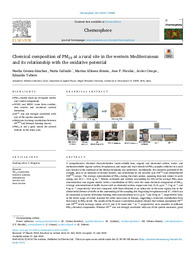Título :
Chemical composition of PM10 at a rural site in the western Mediterranean
and its relationship with the oxidative potential |
Autor :
Gómez-Sánchez, Noelia
Galindo, Nuria 
Alfosea Simón, Marina 
Nicolás, José F.
Crespo, Javier
Yubero Funes, Eduardo  |
Editor :
Elsevier |
Departamento:
Departamentos de la UMH::Física Aplicada |
Fecha de publicación:
2024 |
URI :
https://hdl.handle.net/11000/32688 |
Resumen :
A comprehensive chemical characterization (water-soluble ions, organic and elemental carbon, water- and
methanol-soluble organic carbon, levoglucosan, and major and trace metals) of PM10 samples collected in a rural
area located in the southeast of the Iberian Peninsula was performed. Additionally, the oxidative potential of the
samples, used as an indicator of aerosol toxicity, was determined by the ascorbic acid (OPAA) and dithiothreitol
(OPDTT) assays. The average concentration of PM10 during the study period, spanning from late winter to early
spring, was 20.2 ± 10.8 μg m 3. Nitrate, carbonate and calcium (accounting for 20% of the average PM10 mass
concentration) and organic matter (with a contribution of 28%) were the main chemical components of PM10.
Average concentrations of traffic tracers such as elemental carbon, copper and zinc (0.31 μg m 3, 3 ng m 3, and
9 ng m 3, respectively) were low compared with those obtained at an urban site in the same region, due to the
almost total absence of traffic in the surrounding of the sampling site. Regarding levoglucosan and K+, which can
be considered as tracers of biomass burning, their concentrations (0.12 μg m 3 and 55 ng m 3, respectively) were
in the lower range of values reported for other rural areas in Europe, suggesting a moderate contribution form
this source to PM10 levels. The results of the Pearson’s correlation analysis showed that volume-normalised OPAA
and OPDTT levels (average values of 0.11 and 0.32 nmol min 1 m 3, respectively) were sensitive to different
PM10 chemical components. Whereas OPAA was not strongly correlated with any of the species measured, good correlation coefficients of OPDTT with water-soluble organic carbon (r = 0.81) and K+ (r = 0.73) were obtained,
which points to biomass burning as an important driver of the DTT activity.
|
Palabras clave/Materias:
PM10 composition
Oxidative potential
Dithiothreitol
Ascorbic acid
Rural location |
Área de conocimiento :
CDU: Ciencias puras y naturales: Física |
Tipo de documento :
info:eu-repo/semantics/article |
Derechos de acceso:
info:eu-repo/semantics/openAccess
Attribution-NonCommercial-NoDerivatives 4.0 Internacional |
DOI :
https://doi.org/10.1016/j.chemosphere.2024.142880 |
Publicado en:
Chemosphere 363 (2024) |
Aparece en las colecciones:
Artículos - Física Aplicada
|
 La licencia se describe como: Atribución-NonComercial-NoDerivada 4.0 Internacional.
La licencia se describe como: Atribución-NonComercial-NoDerivada 4.0 Internacional.
.png)
